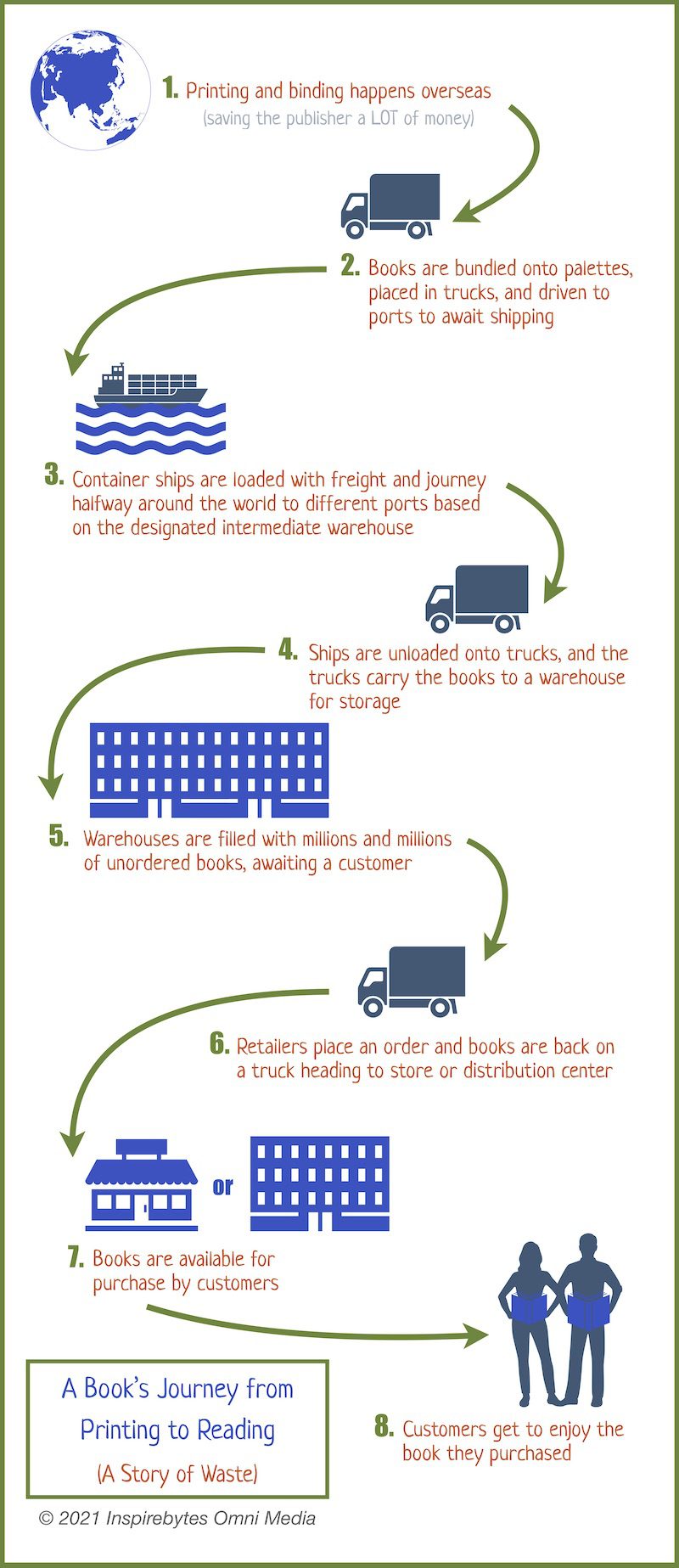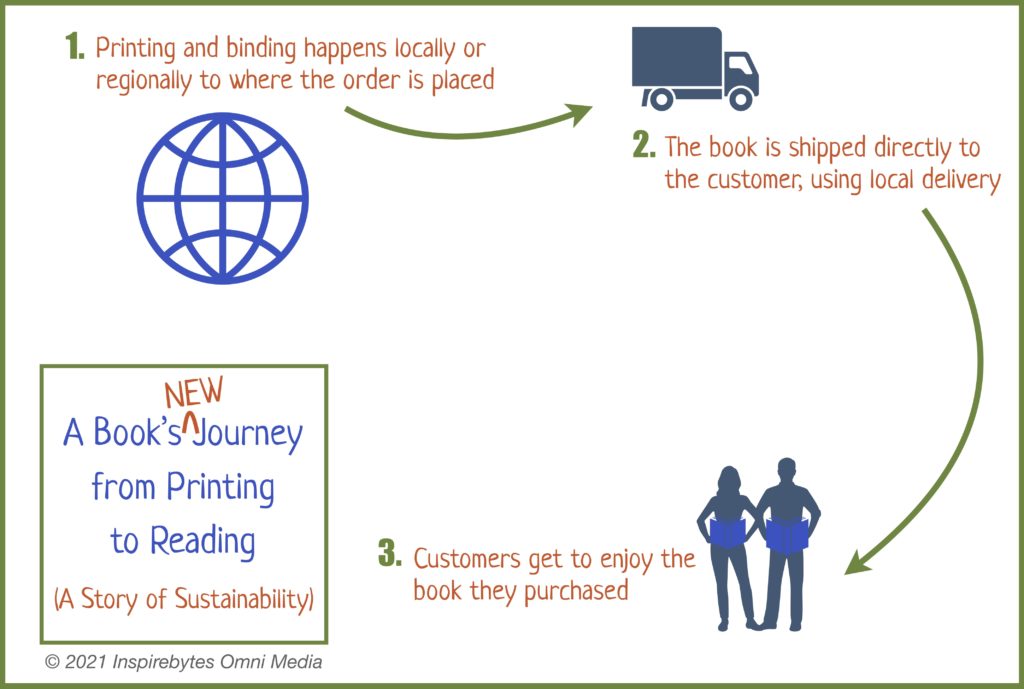
A Message from IOM’s Founder
When I started IOM, I knew that I wanted to do things differently. For me, this meant that I needed to look at all the various aspects of publishing to see what needed improvement—from signing authors and artists to getting our books and products into the hands of our readers and customers. Changing contracts to be more talent-friendly was easy. Adjusting publishing timelines and controlling costs was also somewhat easy to change. However, when I started to understand how much waste is involved in the actual process of producing books, I realized something drastically different had to be done. This is why we have chosen to use Print-On-Demand (POD) technology for nearly all of our books and products, and we always include an ebook version whenever possible.
Of course, POD isn’t 100% perfect (seriously, we have a few tales to tell!), but the error rate thus far has been less than 0.1%, and we think that’s worth it when it comes to making better choices for the future of our planet. We hope you agree. If your book arrives and it’s not printed perfectly, please return it to the retailer for a replacement and request that the original book be removed from stock so that nobody else receives it. This small gesture helps everybody get better at this technology.
Read on if you’d like to learn more about how and why Print-On-Demand helps make the publishing process much more sustainable. (See the diagrams below to get a quick snapshot of just how different this can be.)
Martina E. Faulkner, Founder of IOM
Why Print-On-Demand?
Most publishing houses don’t share actual numbers related to the books they publish, so it’s often very difficult to get real data on the publishing industry as a whole (learn more). This can be detrimental to the industry, as it prevents coordinated and collaborative efforts to create positive change. However, there are a few things we do know:
- According to WIPO and IPA, there are an estimated 2+ million books published globally every year [learn more]
- Most books sell in the 100s of copies—not 1,000s or 10,000s+ as many believe (or hope)
- Printing overseas often requires a minimum quantity (often in the 1,000s) to be worthwhile and to get the lowest cost and increase profit margins for the publisher
- Any advances paid to an author plus other production costs (typically including all of the bulk printing costs) are recouped by the publisher before royalties kick in
Knowing this, it’s not surprising that most publishing is done very cheaply overseas. However, there are more than a few problems with this process and the impact it has on our world. (see diagram below)
Overseas Printing Has Numerous Points of Waste
Printing and binding overseas is good for a company’s bottom line, but not necessarily good for either the author or the planet. The simple fact is that the same amount of raw material (i.e. paper, ink, and glue) is used for a book regardless of where it’s made. This is fixed. The variable is the cost for the raw material, the labor, and the process to get the finished product to the consumer (i.e. transportation).
By moving production overseas to countries who can offer reduced costs for raw materials and labor, the publishing company directly impacts its bottom line for the better—even with the large minimum print runs required (that may never sell). This means that for an order of 5,000 books, for example, if only 500 ever sell the remaining 4,500 will sit in boxes in climate-controlled warehouses for years. This is another source of waste. Even worse, they may be destroyed, which is more waste.
Let’s take a look at how the overseas model for printing books unfolds (see diagram below):
Current publishing production model – In this model, there are at least five points of shipping (often more) before a single book reaches its reader. From production to storage to transfers to shipping to transfers to more storage…this process requires a vast amount of fuel and manpower. (While we are 100% in support of creating jobs, we don’t support creating waste if we can avoid it).
Once the books arrive at their final (or semi-final) facility, there is the ongoing energy cost of climate-controlled storage since books need to be warehoused appropriately.
When you consider that most minimum orders for printing are in the thousands, and most books sell in the hundreds, it’s clear that there is a lot of waste going on at the warehouse level alone. When you add that to the fuel needed for all the various stages of shipping, it simply doesn’t make sense to continue to produce books this way, especially when we have the technology to do it differently.
Of course, it would be amazing if more people opted for digital content, such as ebooks. While ebooks still use resources for electronic storage and digital space, their carbon footprint is much smaller than a hard copy’s will ever be.
At the end of the day, this model is antiquated and predominantly still used to increase the publishing company’s bottom line, which would be great if those benefits passed on to the author, but more often than not, they don’t. This method also does harm in other ways.
Impact on the Environment
One of the often-overlooked impacts that so much shipping has on our environment is the disruption of natural habitats for wildlife. I recently saw a video of a whale (tagged for scientific tracking) trying to feed in its traditional habitat, but being completely disrupted or prevented from doing so by the congested and chronic shipping occurring in the same area.
While we normally pay attention when there is an ecological accident or something like an oil spill, the truth is the day-to-day process of shipping can also affect our environment in negative ways. It has a direct (often negative) impact on the natural behaviors of wildlife.
So, what’s different with POD?

Local Printing Helps the Planet
How does POD change this model? To begin with, there are significantly less steps in the process, which means significantly less resources used and less waste. A book will require the same amount of raw materials (paper, ink, and glue) regardless of where it’s printed. Every resource used beyond those basics is an opportunity for change.
So, let’s look at the steps involved in the new process, which leverages Print-On-Demand technology:

There is a lot less waste using the Print-On-Demand model for publishing books. With only 2 or 3 steps from production to consumer, this technology eliminates the need for all the transportation.
Perhaps more importantly, this process also ensures that a book is only made when there is a buyer. This reduces waste of raw materials and subsequently removes the need for additional climate-controlled storage and the energy used to maintain all the extra books that haven’t been purchased but were printed.
These factors alone should be more than enough reason to switch to POD technology. However, there are also additional benefits to using POD that we should consider.
Local Printing Creates Local Jobs
By choosing POD to publish our books (and products), we are opting to keep resources local to the consumer. This means less waste in shipping and storage, while also supporting local jobs and potentially increasing opportunities for local or regional vendors to supply the raw materials needed.
Local Printing Helps the Author
Author’s royalties seem to have become a moving target. In recent years, the emphasis has been on the advance an author receives, as royalties are not always guaranteed. Given this publishing model and all of its waste, it’s not surprising (nor unexpected) that agents have pushed for larger and larger advances in order to protect their clients. However, there is another way.
By using POD technology, costs can be more easily controlled, as they are fixed from the outset. When costs are controlled, royalties can kick in much sooner with fewer units sold. This benefits the author, the publishing house, and the customer, because it means more work can be created more easily, which makes everyone happy.
As you can see, leveraging technology and using tools like Print-On-Demand is a better solution for everyone involved. Here at IOM, we think it’s worth the occasional error that happens in printing, in order to do something smarter and more beneficial for the planet, our authors, and our customers. We hope you agree.
A Note About FSC Paper
FSC paper means paper that is responsibly sourced. You can learn more about it here. FSC paper is increasing in popularity and is slowly becoming the industry standard, but it’s not 100% yet. It’s also not currently available as an option in the POD model.
While this is something we wish we could choose, we believe that between the two, opting for POD is more important at this time as it has a much greater immediate impact on the environment. Of course, we will choose FSC paper as soon as it’s available, which we hope will be in the near future.
